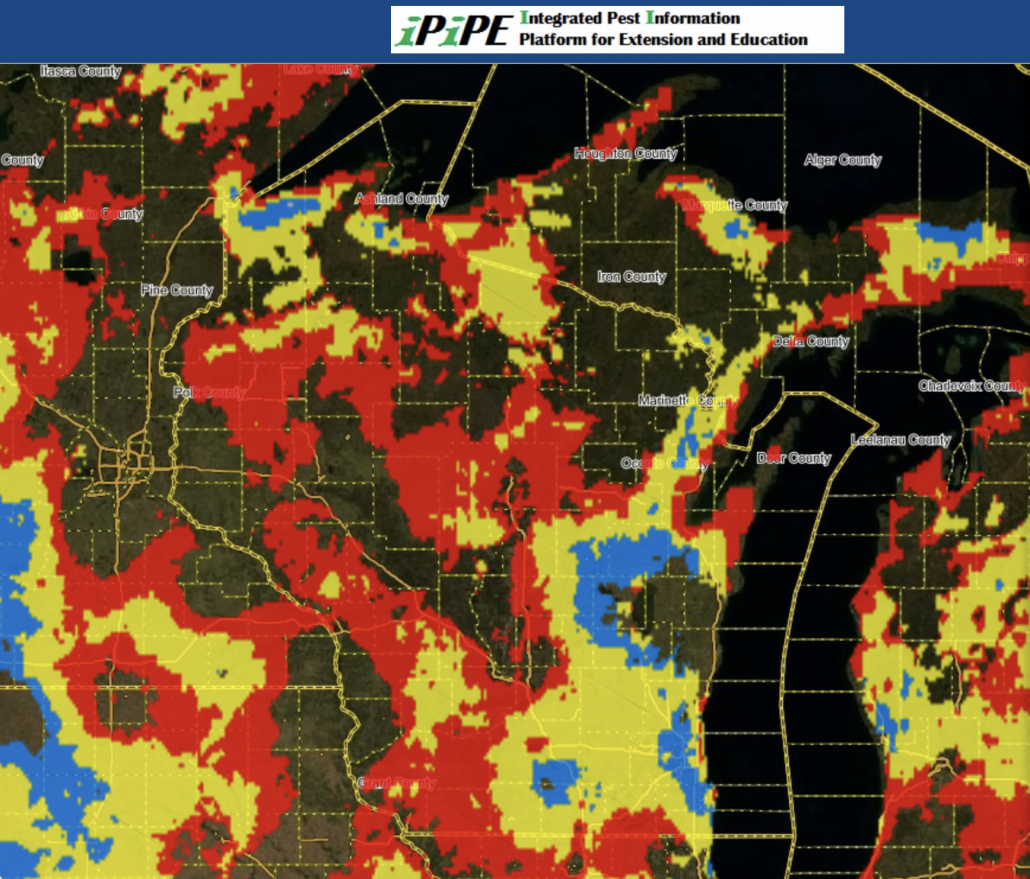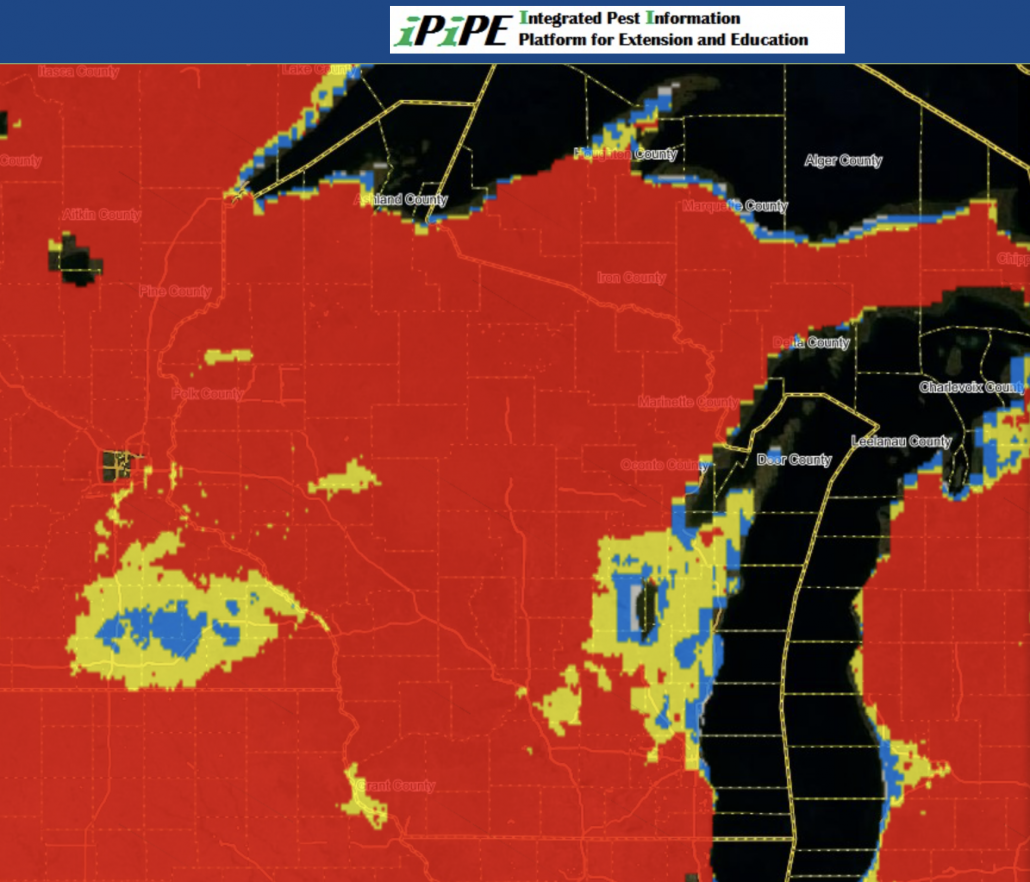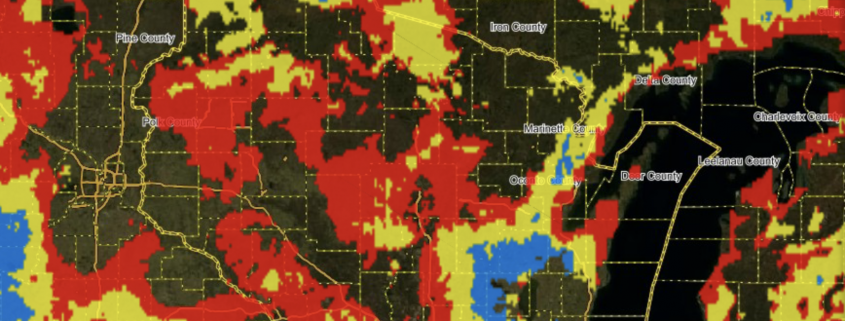Wisconsin White Mold Risk Maps – July 29, 2018
Damon L. Smith, Extension Field Crops Pathologist, University of Wisconsin-Madison
**These maps are for guidance only and should be used with other sources of information and professional advice when determining risk of white mold development. For field-specific predictions, we encourage you to use the Sporecaster smartphone application. These predictions will be most accurate for your specific location. Information about Sporecaster and how to download can be found by clicking here. Sporecaster takes into account crop phenology, in addition to weather parameters, to make field-specific recommendations. The maps below are based on weather only and you must determine if your crop is currently phenologically at risk for infection. For more information on white mold and how to manage it, see my previous post.**
Map Legends: No color = model is inactive and risk of apothecia in the field is not likely; Gray = apothecia might be present, but likelihood of apothecial presence is extremely low; Blue = low risk of apothecia; Yellow = medium risk of apothecia in the field; Red = high risk of apothecia in the field. Model predictions must be combined with soybean growth stage and canopy characteristics to aid in timing of fungicide sprays.

Figure 1. White Mold Risk Map for Non-irrigated Fields – July 29, 2018
Cooler, dry weather has changed the white mold risk map over the last several weeks for non-irrigated (dryland or rain-fed) soybean fields (Figure 1). Cool weather has generated some areas of high risk in the southwest, western, and north-central regions of the state. However, the dry conditions have dissipated much of the moderate and low risk areas that showed several weeks ago. Risk in general is much more spotty than it has been. The soybean crop is also moving through growth stages much more rapidly than in 2017. Thus, the risk window for infection by the white mold fungus will end soon. Remember that once the crop has finished flowering risk of new infections is low to non-existent. In addition, late applications (R4 and later growth stages) of fungicide will not be needed for white mold control.

Figure 2. White Mold Risk Map for irrigated fields planted on 15″ row-spacing – July 29, 2018
Risk remains high across much of the state for irrigated soybeans planted to 15″ rows (Figure 2). Risk is starting to dissipate in areas in the east-central region, due to dryer conditions. However, a fungicide application should be considered if irrigating and soybeans are flowering and planted to a 15″ row-spacing. Note that if you have irrigation in your field but are not actually irrigating, you should be using the non-irrigated model above to make an accurate prediction of white mold risk.

Figure 3. White Mold Risk Map for irrigated fields planted on 30″ row-spacing – July 29, 2018
Risk of white mold in irrigated fields planted to 30″ row-spacing has decreased a bit in some areas, since the last post (Figure 3). However, Much of the state is at risk if irrigating on 30″ spaced soybeans. In these areas, a fungicide application should be considered if soybeans are being irrigated, canopy is nearly closed, and flowers are present. Note that if you have irrigation in your field but are not actually irrigating, you should be using the non-irrigated model above to make an accurate prediction of white mold risk.
These models were developed at the University of Wisconsin-Madison in conjunction with Michigan State University and Iowa State University to identify at-risk regions which have been experiencing weather favorable for the development of white mold fungus apothecia. Weather information and maps are provided by the Soybean Integrated Pest Information Platform for Extension and Education (iPIPE), which is managed by ZedX, Inc. These models predict when apothecia will be present in the field using combinations of 30-day averages of maximum temperature, relative humidity, and maximum wind speed. Using virtually available weather data, predictions can be made in most soybean growing regions. Based on these predictions, a map is generated under three scenarios (non-irrigated soybeans, soybeans planted on 15″ row-spacing and irrigated, or soybeans planted on 30″ row-spacing and irrigated). The maps are colored to show the likelihood of apothecial presence within a region. If the model is predicting high risk (red) in your area for your planting scenario, the soybeans are flowering, and the canopy is somewhat closed, then the white mold risk is high. If your fields are at-risk, we recommend to consult your local extension personnel or other research-based resources for the best in-season management options for your area.






Leave a Reply
Want to join the discussion?Feel free to contribute!